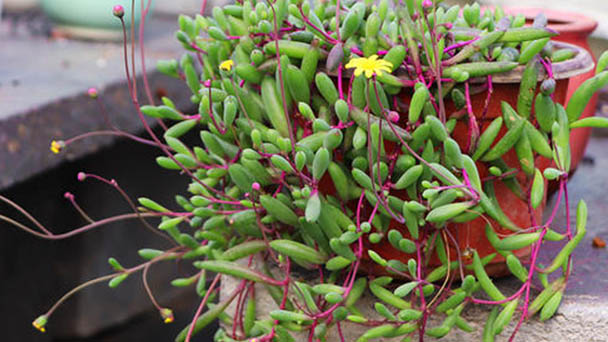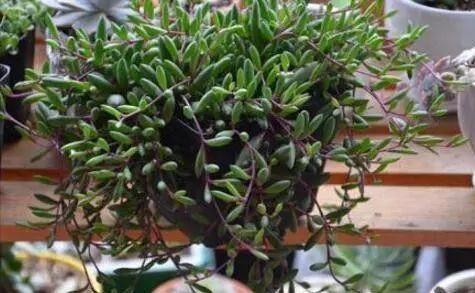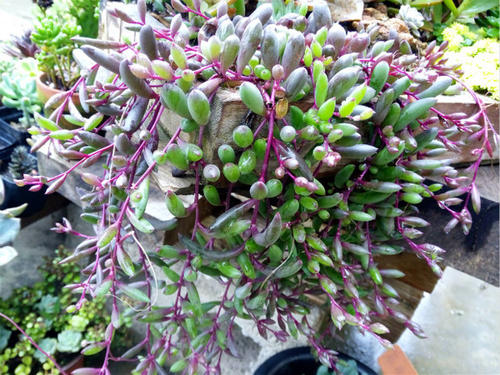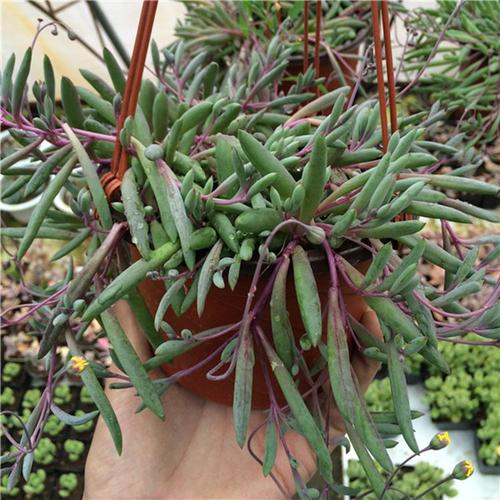Othonna Capensis L. H. Bailey profile
Written by Maggie
Aug 31 2021

The origin of Othonna Capensis L. H. Bailey has not been officially recorded. Othonna Capensis L. H. Bailey is one of the chlorophyta species of succulent plants. Its leaves are so peculiar that they are often mistaken for The Genus Cerasus.
Othonna Capensis L. H. Bailey picture

Morphological characteristics of Othonna Capensis L. H. Bailey
The leaves of othonna capensis L. H. Bailey are long and slightly curved, like a crescent, clustered at the base, and alternate with growth. Yellow florets open in spring, the stems and leaves will turn from green to purplish red under the condition of sufficient light.
Othonna Capensis L. H. Bailey growth environment
Othonna Capensis L. H. Bailey prefers a sunny, warm, and dry environment. Semi-dormant in the middle of summer, reduce watering and do not fertilize. In Growing season watering can be dry, see wet, applying phosphorus and potassium compound fertilizer once a month. Safe wintering temperature is above 10℃.
The distribution range of Othonna Capensis L. H. Bailey
Othonna Capensis L. H. Bailey is mainly distributed in South Africa and other places.
The main value of Othonna Capensis L. H. Bailey
Othonna Capensis L. H. Bailey is suitable for adding combined potted plants as ornaments, especially the basket basket and ironwork basket that are exposed to the yard and terrace. othonna Capensis L. H. Bailey is also good in its own cultivation. Its growth speed is super fast, and it will explode the pot soon. When there is enough sunshine, it is very beautiful, so try to choose a larger flower ware.
Othonna Capensis L. H. Bailey doesn't have large and gorgeous flowers, but it is gentle like a small jasper and clear and beautiful like a Su embroidery picture. It is very suitable to decorate the windowsill. Especially the leaves like green stones, with a little purple, full of temptation, implying nobility, simplicity and richness.

Cultivation technique of Othonna Capensis L. H. Bailey
Othonna Capensis L. H. Bailey grew to a temperature of 15-28 degrees, with no less than 10 degrees in winter , with soil generally available peat, vermiculite, perlite mixed soil. Water well when growing. Fertilization usually happens once a month during the growing period. Propagation methods include sowing, planting and cutting, generally using cutting propagation. It is easy to survive, in the early spring, or late autumn growth season.
Reproductive method of Othonna Capensis L. H. Bailey
Othonna Capensis L. H. Bailey was mainly cut, which was very easy to reproduce. Cut off a section of branches, let the wound dry, insert it into the substrate or lay it flat and bury it in the basin soil, spray the cuttings and substrate wet.
Othonna Capensis L. H. Bailey can be propagated by cutting, the growth rate is fast, the growth period needs a lot of water.
The propagation method of Othonna Capensis L. H. Bailey was leaf cutting or cutting. Because of the super fast growth rate, cutting was the fastest and easiest way to survive, and survival could be obtained by cutting a section and inserting it into the soil.

The conservation method of Othonna Capensis L. H. Bailey
Good ventilation by exposure. Othonna Capensis L. H. Bailey does not sleep properly in the summer and grows extremely rapidly. Cutting a seedling in the soil, within a month it can grow into a large piece. Therefore, to grow a good Othonna Capensis L. H. Bailey, it is necessary according to the local climate. In the late autumn, Othonna Capensis L. H. Bailey, with its small yellow flowers, looks like a Daisy.
In the late autumn peak season, if the Othonna Capensis L. H. Bailey is too saturated, the leaves can be cut off and 3 to 4 leaf nodes can be retained. After the wound is dried, the leaves can be inserted or laid half in another basin-soil, and the cuttings and matrix can be sprayed wet to reproduce new plants without too much treatment.
Latest Updated
- Benefits of Bugleweed - 7 Science-backed Health Benefits
- Bugleweed Dangers & Side Effects - Is It Poisonous?
- How to Plant Evergreen Trees - What You Should Know
- When to Plant Evergreens - Grow Guide for Evergreen Trees
- 12 Wonderful Evergreen Shrubs for Your Garden
- 12 Popular Evergreen Plants with Pictures for Beginners
- When And How To Prune A Lilac Bush Like a Pro
- How to Grow & Care for Lilac Vine (Hardenbergia Violacea)
- Japanese Lilac Tree (Syringa Reticulata) Care & Propagation Guide
- Shumard Oak Pros and Cons - What to Know
Popular Articles
- Winter maintenance of Antirrhinum Majus
- How to Grow Terminalia Mantaly Tree
- How to Grow and Care for Crossostephium Chinense
- How to grow Antirrhinum Majus in spring
- Peristeria Elata (Dove Orchid) Profile: Info & Care Guide
- Underwatered Snake Plant (Sansevieria Trifasciata) - Signs And How To Fix
- How to Care for Brazilian Jasmine Plant (Mandevilla Sanderi)
- How to Grow & Care for Graptopetalum Purple Delight in Summer
- Rosa Chinensis (China Rose): Plant Growing & Care Tips
- How to Care for Baby Sun Rose (Aptenia Cordifolia)